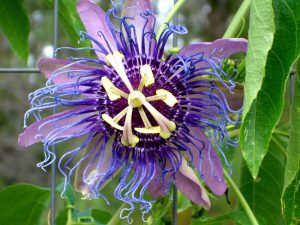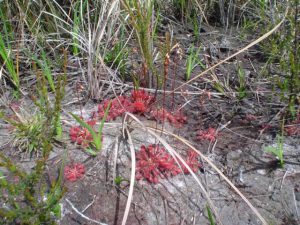
The passionflower vine is beautiful and attracts butterflies, but can also be used for food and sedation drugs. Photo credit: Dorothy Birch
Ethnobotany lies at the intersection of culture, medicine, and mythology. The “witch doctors” and voodoo practitioners, the followers of the Afro-Cuban religion of Santeria, and the wise elders of ancient Chinese civilizations are all ethnobotanists. So, too, are the modern day field biologists who discover and develop medicinal plants into an estimated half of our pharmaceutical drugs. Simply put, ethnobotany is the study of how people and cultures (ethno) interact with plants (botany).
For tens of thousands of years, humans have been learning about plants’ chemical, nutritious, and even poisonous properties. Plants evolve these properties to defend themselves against pathogens, fungi, animals and other plants. Other properties, like color, scent, or sugar content may attract beneficial species. Humans most likely started paying attention to plant characteristics to decide whether to eat them. From there, one can imagine people started using plants to build structures or use fiber for ropes, baskets, and clothing.
My first experience with the idea of ethnobotany was as a college student on a study tour of Belize. A professional ethnobotanist took us on a tour of the Maya Rainforest Medicine Trail, pointing out dozens of native trees, shrubs, and grasses used for medicinal and cultural purposes by local tribes. From birth control and pain relief to chewing gum and pesticides, the forest provided nearly everything Central American civilizations needed to survive for thousands of years and into the present. The tour captured my imagination as I considered the possibilities yet undiscovered in the deep rainforests worldwide.
Of course, there is no need to travel out of the country, or even the state, to learn about useful native plants. One of my favorite publications put out by UF IFAS Extension specialists is “50 Common Native Plants Important in Florida’s Ethnobotanical History.” Another fascinating source of information about historic, cultural, and even murderous uses of plants is Amy Stewart’s Wicked Plants: The Weed That Killed Lincoln’s Mother and Other Botanical Atrocities. Plants with interesting historical uses make for great stories along a trail, and help create a connection between the casual observer and the natural world around them.
A handful of interesting native plants with significant medicinal properties include the cancer-fighting plants saw palmetto (Serenoa repens) and mayapple (Podophyllum peltatum). Saw palmetto berries are used for prostate cancer treatment, while the $350+ million annual Florida mayapple harvest helps produce chemotherapy drugs for several types of cancer. The carnivorous bog plant, pink sundew (Drosera capaillaris) uses enzymes to break down insect protein, and Native American tribes used the plant for bacterial and fungal skin disorders.

Sundews, tiny carnivorous plants found in pitcher plant bogs, use an enzyme to dissolve insect proteins. Native Americans recognized this property and used the plant for skin maladies. Photo credit: Carrie Stevenson, UF IFAS Extension
Many plants had (and still have) multiple uses. Yaupon holly (Ilex vomitoria) leaves brewed as a highly caffeinated tea were used ceremonially and before warfare by many southeastern American Indian tribes, and then later by early American settlers when tea was difficult to import. Holly branches were used for arrows, and the bark for warding off nightmares. The purple passionflower, or maypop (Passiflora incarnata) vine attracts butterflies and produces a pulp used for syrups, jams, and drinks. Passionflower extract has also been developed into dozens of drugs and supplements for sedation.
Early civilizations living closer to the land knew many secrets that modern medicine has yet to unlock. Thanks to the ethnobotanists, the field and forest will continue to heal and provide for us for many generations yet to come.
CAUTION: Many of the plants listed or referenced can have hazardous or poisonous properties without appropriate preparation or dosage. Allergic reactions and prescribed drug interactions may occur, and many unproven rumors exist about medicinal uses of plants. Always consult a physician or health professional before trying supplements.
- Yucca–A Tough and Versatile Native Plant - November 26, 2025
- Blazing Star - November 6, 2025
- University of West Florida’s New Heritage Roots Garden - October 17, 2025
